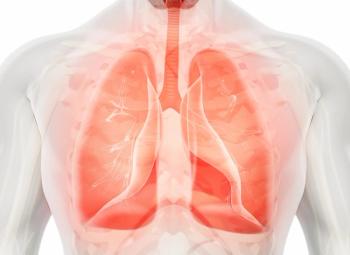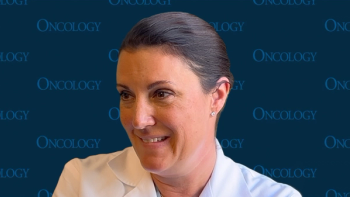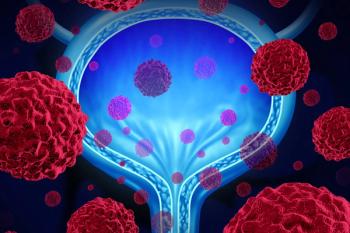
Rhenium Obisbemeda Improves Survival in Recurrent Glioblastoma
Andrew Brenner, MD, PhD, discussed rhenium obisbemeda and results from the ReSPECT-GBM trial for patients with glioblastoma.
Previous studies assessing glioblastoma have shown an average overall survival (OS) of about 8.5 months. However, results from the phase 1/2 ReSPECT-GBM trial (NCT01906385) are showing an increased OS, according to Andrew Brenner, MD, PhD.1,2
Brenner, a professor of medicine in the Division of Hematology and Oncology at The University of Texas Health Science Center at San Antonio, spoke with CancerNetwork®, regarding rhenium obisbemeda and the results from the ReSPECT-GBM trial. These outcomes are significantly improved compared with historical controls for recurrent glioblastoma, showing high absorbed doses with minimal adverse effects and a correlation between absorbed radiation dose and OS.
Overall, the discussion focused on the mechanism of action of rhenium obisbemeda, the trial results observed, and where the future of glioblastoma research is headed.
CancerNetwork: What is the mechanism of action of rhenium obisbemeda?
Brenner: Rhenium obisbemeda is a liposomal encapsulated radioisotope using a chelator called BMEDA. We’ve had liposomal encapsulated chemotherapies for a long time, and the liposomal encapsulation changes the characteristics of the chemotherapy. For example, the [adverse] effect profile of doxorubicin liposomal is much different from that of doxorubicin because it changes the kinetics, where the distribution is, and things of that nature. Liposomal encapsulation is important for helping with distribution and retention, and it’s never been done for radio therapeutics before. We’re on the cusp of changes with the increased incorporation of liquid radiation into the management scheme.
There are several examples, and there are going to be more over the years. Whether it’s lutetium Lu 177 dotatate, which uses a radioisotope conjugated peptide to get the radiation to the tumor. In this case, what we were able to do was generate a custom molecule called BMEDA and it has this trident-like structure with the sulfhydryl groups, and that allows it to intercalate, and basically chelate different radioisotopes. The one we used is Rhenium-186, in this application, but you can use that same chelator for a number of different radiotherapeutics, and they become pH-dependent. At a neutral pH, it loses its charge and becomes easily able to enter through a lipophilic membrane, like in liposomes. Once we add the chelator, BMEDA, to the isotope, the isotopes readily enter the liposomes. We have the pH of the liposome such that it’s a higher pH, and that causes it to re-protonate or regain charge, and then it’s stuck; it can’t go back across that lipid bilayer.
The isotope Rhenium-186 has a path of about 2 mm, and has a very high energy, a 1 of 10 [radioactive nuclei] decay is a gamma, like a photon, so it can be detected by standard SPECT imaging. What we’re doing is we’re changing the isotope so it can be retained within tissue and distributed throughout tissue. If we injected just Rhenium-186, it would get taken up by the blood vessels and dumped in the urine or in the feces. In this case, it becomes trapped within the tissues by the cancer cells themselves, which engulf it. In this case, glioma cells can be phagocytic as well as macrophages or microglia, or any other phagocytic cell will trap it there. What we’re doing is aiding in the retention and distribution of the radioisotopes within the brain tumor.
What patient selection criteria are being used in the ReSPECT-GBM trial, and are there any emerging biomarkers that might predict a better response to this treatment?
In the ReSPECT-GPM trial, we had 2 phases. Initially, [in phase 1] we didn’t restrict [enrollment] in terms of lines of progression of glioblastoma. For phase 2, the most important criterion is that patients have to have recurrent glioblastoma and have not received anti-angiogenic therapy with bevacizumab [Avastin] or any of the biosimilars. There is a rationale why we decided to do this in phase 2. No. 1, we needed historical control, and so we’re comparing this against a similar study, the EORTC [1419 ETERNITY] study in the recurrent setting, which looked at [glioblastoma multiforme] after radiation and chemotherapy.3 We need that historical control, but also because when we administered it to patients who had received prior [bevacizumab], we noticed that the distribution of the drug wasn’t as good. The tumors tend to have a little bit more pressure in them because of the leakiness, and that helps with something called convection, which is the distribution of the drug through the tumor. We want good distribution of this, and so if patients are already on [line 1 of bevacizumab], we can’t use them. We can’t compare them with the historical control we’re using. Also, we need better distribution, and that will interfere with the distribution.
Are you able to give a brief overview of the results of the ReSPECT-GBM trial?
In the study that was recently published, we started with a low dose and increased the dose repetitively until we got to the recommended phase 2 dose. We started with a small volume, basically a little under 1 mL, .66 mL. Then we just kept doubling and doubling and doubling the amount of radiation. We started off with a little over 1 mCi, and then we managed to go all the way up to a total of 22.3 mCi. The recommended phase 2 dose was 22 mCi and 8.8 mL. What we found is that there was no dose-limiting toxicity up to that level. In other words, there was nothing that looked like anything more than mild toxicity at that dose level. We got good distribution. When we looked at the overall safety profile, it was very reasonable. Patients had mainly injection site reactions. We do make a small incision in the scalp and a Burr hole for the placement of the catheter that goes into the tumor. We used anywhere from 1 to 5 catheters, going up in the number of catheters as we moved up in the study, to administer larger doses. There was usually some local discomfort associated with the catheters themselves, but not any significant treatment-related toxicities that were particularly increased, as opposed to what you would see for the typical disease. What we found is that there were higher and higher absorbed doses as we went up, and in the first few cohorts, it remained in the 100 to 200 Gy. In the final cohorts, cohort 5 and cohort 6, we were seeing absorbed doses, that were in the range of 250 to 450 Gy. To put that into perspective, when you use external beam radiation in the recurrent setting, we typically only give 30 Gy. When we treat in the newly diagnosed setting, we give up to 60 Gy. We were achieving 5 to 10 times the absorbed dose without significant toxicity.
When we went back and looked at the activity and the survival of these patients, what we noticed is that, as with any patient, when we limited it to patients who had absorbed doses of greater than 100 Gy, we asked where we were successful in terms of delivering the therapy. Because one of the caveats is that we were still learning about administering it, and so in those cases where we successfully administered it by using a cutoff of 100 Gy or more, there was significantly improved survival. We saw a median OS in those patients of 17 months. Now, if you look at the patients who did not get 100 Gy or more, that was less than half. That also matched what we know historically for glioblastoma, that in the recurrent setting, the typical survival is only about 8.5 months, usually around 8.3 months. Some studies may be up to 9 months. In this case, we were seeing 17 months for those patients, suggesting that there was some efficacy in terms of achieving better survival for these patients.
What adverse effects have been observed in the trial, and how significant are they?
We typically look at all adverse events in terms of this, independent of grade, and then we separate those that are considered moderate or severe, grade 3 or grade 4. Almost all the adverse events were mild. The most common that we saw was fatigue. A little over 50% of patients reported fatigue, independent of attribution. That means that could be disease-related or treatment-related, but low-grade. We saw a headache in about 40% of patients, and then after that was cerebral edema, which was one of the ones we saw in about 24% of [patients]. One of 4 [patients] had some incidents of swelling, but those did not reach grade 3 or grade 4 in terms of any severe toxicities we saw; only about 8% of patients had a grade 3 event on the recommended phase 2 dose. That’s cohort 6 dose, and those were not felt to be treatment-related.
Where do you see rhenium obisbemeda fitting into the treatment paradigm for glioblastoma and leptomeningeal disease?
We are also studying [rhenium obisbemeda] in leptomeningeal disease. In leptomeningeal disease, we’re seeing similar excellent results for glioblastoma. In the setting that we’re currently studying, it is in the recurrent setting following chemoradiation, but prior to any anti-angiogenic therapy, and it’s going to be in phase 2. We’re limiting it to tumors of 20 mm or less. Why? Because we know we can get a good distribution of the drug; we routinely saw that we were getting about 30 mLs of distribution. That correlates to about a 2.5 cm tumor. When we consider that 90% of the recurrences tend to be within a couple of cm of the resection cavity and tend to be within that size—about two-thirds to three-quarters of tumors tend to fall within that size range—we should be able to allow the bulk of patients to participate. It is broad inclusion in terms of not having received prior bevacizumab and then being in that tumor size, and that’s what we’re going for in terms of indication.
Where is the field of glioblastoma treatment headed?
There’s a lot of hope and optimism in terms of that we are going to either find a targeted agent or get immunotherapy to work. So far, we’ve had a lot of difficulty with targeted agents because of the significant heterogeneity of these tumors and their ability to adapt, where you block 1 pathway, another one just pops up and basically circumvents anything that you’re inhibiting. We’ve tried a number of different things, like EGFR inhibitors and PARP inhibitors over the years, but there’s still significant hope for immunotherapies. Maybe not the conventional checkpoint inhibitors that we are seeing work for other tumor types like lung cancer and melanoma, but rather either in a cellular therapy like CAR T, or dendritic cell vaccines, where we use the patient's tumor to train the immune system to attack the tumor. Dendritic cell vaccines, CAR T-cell therapy, and things of that nature are holding some promise.
References
- Plus Therapeutics announces peer-reviewed publication in Nature Communications highlighting promising phase 1 results for rhenium (186Re) obisbemeda in glioblastoma. News release. Plus Therapeutics. March 7, 2025. Accessed May 30, 2025. https://tinyurl.com/4yvc59vn
- Plus Therapeutics reports ReSPECT-GBM clinical trial update at the 2024 Congress of Neurological Surgeons Annual Meeting. News release. Plus Therapeutics. October 1, 2024. Accessed May 30, 2025. https://tinyurl.com/mr33wjwy
- Studying long-term survivors of glioblastoma may pave the way to better treatment. News release. EORTC. May 10, 2023. Accessed May 30, 2025. https://tinyurl.com/58f7kkkm
Newsletter
Stay up to date on recent advances in the multidisciplinary approach to cancer.


















































































